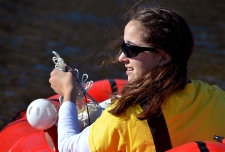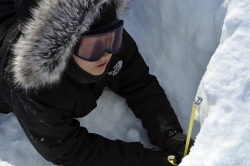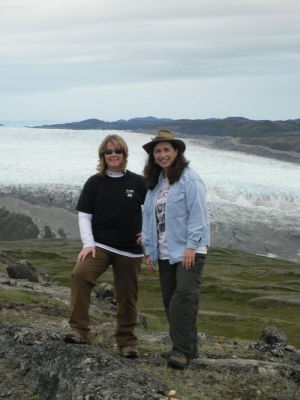In July 2012, a group of high school students from three arctic nations visited research facilities in Greenland to participate in the Joint Science Education Program (JSEP), a cultural and scientific exchange between Denmark, Greenland, and the United States. For the past five years this program has brought students together for first-hand experience with arctic research and to learn about each other's language, customs, and cultures. Under the guidance of teachers from all three nations, the students worked alongside researchers in activities that included gathering snow samples to gauge the effects of atmospheric pollution, measuring methane release from arctic lakes, and descending into an ice pit to see how annual layers of snow turn into layers of ice.

JSEP is divided into two complementary programs. The Greenlandic-led Field School is based in the community of Kangerlussuaq, which is an international logistics hub for arctic science located in southwest Greenland. The Science Education Week is coordinated by NSF and based at Summit Camp, which is NSF's high-elevation, geophysical, and atmospheric research station at the top of the ice sheet in central Greenland.
Field School students observed and interacted with professional researchers, worked cooperatively in groups to conduct their own field measurements, and culminated their experience with presentations of their research data and conclusions.
Field School students also observed dramatic effects of a rare warming of the atmosphere over the ice sheet and subsequent surface melting during the 2012 summer season. The climate in Kangerlussuaq is arctic, with temperatures averaging 5–18°C (41–64°F) in July. During the unusually warm July of 2012, local temperatures exceeded 21°C (70°F) and students saw water in the Watson River—which they had sampled earlier to determine flow rate—rise high enough to damage the bridge spanning the river.

During the Science Education Week at NSF's Summit Camp a small group of students spent several days working in science field camps on the Greenland ice sheet at altitudes of thousands of meters above sea level. In one field experience—provided by Kaitlin Keegan, a PhD student at Dartmouth College—students descended into a backlit snow pit where they were able to observe layers of snow, firn, and ice. JSEP student Marisa LaRouche reflected on this experience, saying, "I thought that was really interesting. Particularly because you can see the different storm patterns and different ways the snow forms and crystalizes. It was really cool to see that in action because I've heard so much about it." LaRouche had previously been a summer intern at the University Corporation for Atmospheric Research in Boulder and is now a student at the Colorado School of Mines.
At Summit, students also participated in an NSF-funded distance-learning pilot project, led by Brant G. Miller and R. Justin Hougham of the University of Idaho. This project allowed students to take measurements with off-the-shelf hand-held instruments that mimic the functions of the more sophisticated scientific instruments at Summit Station as part of the Integrated Characterization of Energy, Clouds, Atmospheric state, and Precipitation at Summit (ICECAPS) project. For example, students used thermal imagers and infrared thermometers to determine how clouds affect the surface temperature of the ice sheet. Through the use of Miller and Hougham's "Adventure Learning" approach to distance education students in Greenland were able to share their measurements with students in Idaho via the Internet.

Following their week at Summit station, students spent a night at the international North Greenland Eemian Ice Drilling (NEEM) project. They arrived just as the Danish-led team of researchers concluded a multiyear project to retrieve an ice core that included a climate record as far back as the last interglacial period: the Eemian Period of 130,000 to 114,000 years ago.
While at the NEEM camp, the students experienced another event related to the warming atmosphere over the ice sheet. In the days before students arrived there had been rain instead of snow at the NEEM camp. Alejandra Borunda, an NSF-funded PhD student at Lamont-Doherty Earth Observatory in New York, gave students an opportunity to help with a novel experiment in which various nontoxic and brightly colored liquids were poured on the surface and allowed to permeate into the ice sheet and disperse. Students then excavated pits and measured the depth and extent to which the various liquids infiltrated into the ice in order to understand the effect that the rain would have had on the ice layers.
Through their experiences at JSEP, the students were exposed to dimensions of science, logistics, geography, and culture that they might only have been vaguely aware of before. The experience also had its benefits for the researchers who worked with the students. After sharing her work at Summit camp, Kaitlin Keegan of Dartmouth College reflected, "All the students pointed out their favorite part of the snow pit wall, and that really allowed me to see it from a fresh perspective again. And they were so excited. That helped me to be even more excited about my research."
To view the NSF Web feature video about JSEP 2012 season, go to: http://www.nsf.gov/news/news_videos.jsp?cntn_id=125251&media_id=72992. For information about JSEP media, contact Peter West (pwest [at] nsf.gov).
For further information about JSEP, see: http://www.arcus.org/jsep or contact 2012 Albert Einstein Distinguished Educator Fellow, Lynn Foshee Reed, (lreed [at] nsf.gov) or by phone at NSF Polar Programs (703- 292-8051).
